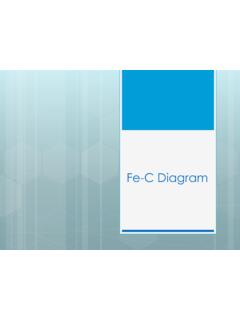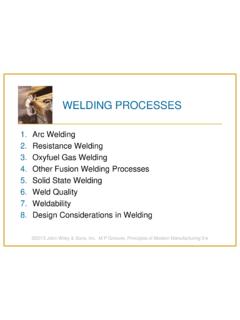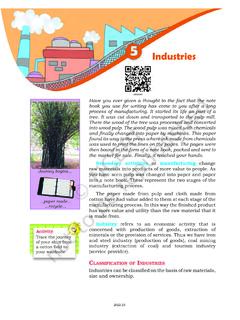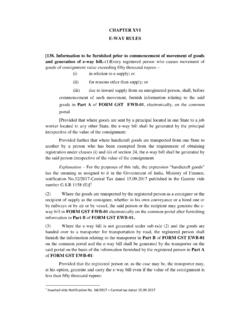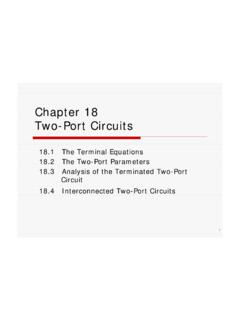Transcription of Chapter 10 VAPOR AND COMBINED POWER CYCLES
1 Chapter 10 VAPOR AND COMBINED POWER CYCLESC opyright The McGraw-Hill Companies, Inc. Permission required for reproduction or : An Engineering Approach, 6thEditionYunus A. Cengel, Michael A. BolesMcGraw-Hill, 20082 Objectives Analyze VAPOR POWER CYCLES in which the working fluid is alternately vaporized and condensed. Analyze POWER generation coupled with process heating called cogeneration. Investigate ways to modify the basic Rankine VAPOR POWER cycle to increase the cycle thermal efficiency. Analyze the reheat and regenerative VAPOR POWER CYCLES .
2 Analyze POWER CYCLES that consist of two separate CYCLES known as COMBINED CYCLES and binary CARNOT VAPOR CYCLET-s diagram of two Carnot VAPOR Carnot cycle is the most efficient cycle operating between two specified temperature limits but it is not a suitable model for POWER CYCLES . Because:Process 1-2 Limiting the heat transfer processes to two-phase systems severely limits the maximum temperature that can be used in the cycle (374 C for water)Process 2-3 The turbine cannot handle steam with a high moisture content because of the impingement of liquid droplets on the turbine blades causing erosion and 4-1It is not practical to design a compressor that handles two cycle in (b)
3 Is not suitable since it requires isentropic compression to extremely high pressures and isothermal heat transfer at variable heat addition in a boiler 2-3isentropic expansion in a turbine 3-4isothermal heat rejection in a condenser4-1isentropic compression in a compressor4 RANKINE CYCLE: THE IDEAL CYCLEFOR VAPOR POWER CYCLESMany of the impracticalities associated with the Carnot cycle can be eliminated by superheating the steam in the boiler and condensing it completely in the condenser. The cycle that results is the Rankine cycle, which is the ideal cycle for VAPOR POWER plants.
4 The ideal Rankine cycle does not involve any internal simple ideal Rankine Analysis of the Ideal Rankine CycleThe efficiency of POWER plants in the is often expressed in terms of heat rate, which is the amount of heat supplied, in Btu s, to generate 1 kWh of thermal efficiency can be interpreted as the ratio of the area enclosed by the cycle on a T-s diagram to the area under the heat-addition energy equation6 DEVIATION OF ACTUAL VAPOR POWER CYCLES FROM IDEALIZED ONES(a) Deviation of actual VAPOR POWER cycle from the ideal Rankine cycle.
5 (b) The effect of pump and turbine irreversibilities on the ideal Rankine actual VAPOR POWER cycle differs from the ideal Rankine cycle as a result of irreversibilities in various components. Fluid frictionand heat loss to the surroundingsare the two common sources of efficiencies7 HOW CAN WE INCREASE THE EFFICIENCY OF THE RANKINE CYCLE?The effect of lowering the condenser pressure on the ideal Rankine basic idea behind all the modifications to increase the thermal efficiencyof a POWER cycle is the same: Increase the average temperature at which heat is transferred to the working fluid in the boiler, or decrease the average temperature at which heat is rejected from the working fluid in the the Condenser Pressure (Lowers Tlow,avg)To take advantage of the increased efficiencies at low pressures, the condensers of steam POWER plants usually operate well below the atmospheric pressure.
6 There is a lower limit to this pressure depending on the temperature of the cooling medium Side effect:Lowering the condenser pressure increases the moisture content of the steam at the final stages of the effect of superheating the steam to higher temperatures on the ideal Rankine the Steam to High Temperatures (Increases Thigh,avg)Both the net work and heat input increase as a result of superheating the steam to a higher temperature. The overall effect is an increase in thermal efficiency since the average temperature at which heat is added to higher temperatures decreases the moisture content of the steam at the turbine exit, which is temperature is limited by metallurgical considerations.
7 Presently the highest steam temperature allowed at the turbine inlet is about 620 the Boiler Pressure (Increases Thigh,avg)The effect of increasing the boiler pressure on the ideal Rankine a fixed turbine inlet temperature, the cycle shifts to the left and the moisture content of steam at the turbine exit increases. This side effect can be corrected by reheating the supercritical Rankine many modern steam POWER plants operate at supercritical pressures (P > MPa) and have thermal efficiencies of about 40% for fossil-fuel plants and 34% for nuclear IDEAL REHEAT RANKINE CYCLEHow can we take advantage of the increased efficiencies at higher boiler pressures without facing the problem of excessive moisture at the final stages of the turbine?
8 1. Superheat the steam to very high temperatures. It is limited Expand the steam in the turbine in two stages, and reheat it in between (reheat)The ideal reheat Rankine average temperature at which heat is transferred during reheating increases as the number of reheat stages is single reheat in a modern POWER plant improves the cycle efficiency by 4 to 5% by increasing the average temperature at which heat is transferred to the average temperature during the reheat process can be increased by increasing the number of expansion and reheat stages.
9 As the number of stages is increased, the expansion and reheat processes approach an isothermal process at the maximum temperature. The use of more than two reheat stages is not practical. The theoretical improvement in efficiency from the second reheat is about half of that which results from a single reheat temperatures are very close or equal to the turbine inlet temperature. The optimum reheat pressure is about one-fourth of the maximum cycle IDEAL REGENERATIVE RANKINE CYCLEThe first part of the heat-addition process in the boiler takes place at relatively low is transferred to the working fluid during process 2-2 at a relatively low temperature.
10 This lowers the average heat-addition temperature and thus the cycle steam POWER plants, steam is extracted from the turbine at various points. This steam, which could have produced more work by expanding further in the turbine, is used to heat the feedwater instead. The device where the feedwater is heated by regeneration is called a regenerator, or a feedwater heater (FWH).A feedwater heater is basically a heat exchanger where heat is transferred from the steam to the feedwater either by mixing the two fluid streams (open feedwater heaters) or without mixing them (closed feedwater heaters).

